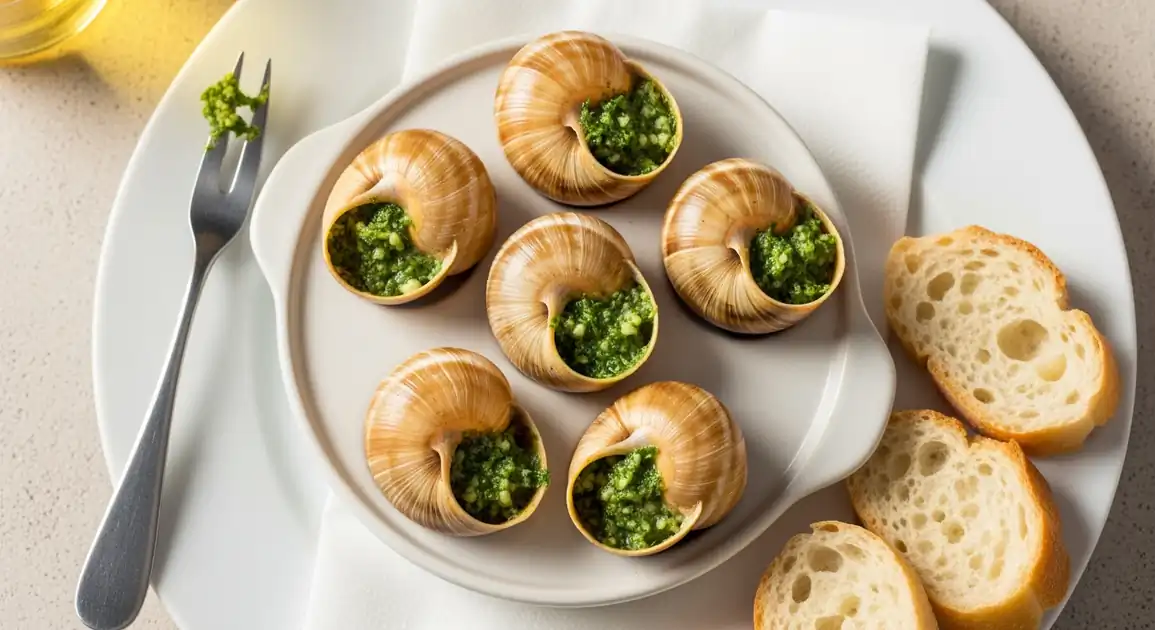Burgundy Snails
Escargots de Bourgogne

Description
Paris offers some of the finest Escargots de Bourgogne in France, from classic bistros serving traditional preparations to innovative chefs adding modern twists. The capital's dining scene balances authenticity with refinement, making it an ideal place to experience this French delicacy at various price points and ambiance levels.
Dietary Information
Serving information
Serving style
In Paris, presentation is particularly important. Expect traditional ceramic escargot plates, proper tools, and often a nice linen napkin. Some high-end establishments might add artistic plating elements or garnishes to the traditional presentation.
Quick facts
Paris lunch service typically 12 PM - 2:30 PM, dinner service 7 PM - 10:30 PM (later on weekends). Many restaurants close between services and some close entirely on Sundays or Mondays.
Safety Tips
What to Look For
-
Piping hot, bubbling butter
Properly prepared escargots should be served extremely hot with the butter actively bubbling. This indicates they've been properly heated through, ensuring food safety.
-
Reputable, established restaurants
Choose bistros and brasseries known for traditional French cuisine rather than tourist-oriented establishments. Quality restaurants take proper care in the extensive preparation process.
-
Proper aroma of garlic and herbs
The dish should have a clean, herbaceous smell dominated by garlic, parsley, and butter. Any strong ammonia or spoiled odors indicate poor quality or improper preparation.
-
Specialized escargot plates and utensils
Restaurants serving authentic escargots will use proper equipment, which often correlates with attention to traditional preparation methods.
What to avoid
-
Cold or merely warm escargots
Escargots must be thoroughly heated. Cold spots or lukewarm butter could indicate improper heating, which is both a safety and quality issue.
-
Pre-prepared escargots sitting under heat lamps
Quality escargots should be finished to order. Avoid places where you can see them sitting prepared beforehand.
-
Extremely cheap escargots at tourist-focused restaurants
Proper escargot preparation is time-consuming and ingredient-intensive. Unusually low prices might indicate corner-cutting in the preparation process or quality of ingredients.
-
Strong fishy or muddy odors
Quality escargots should never smell overly pungent. Off-putting odors suggest poor quality snails or inadequate purging/cleaning during preparation.
Price information
Price range
Budget tips
- Bistros in less touristy neighborhoods like the 11th, 13th, and 20th arrondissements often offer escargots at more reasonable prices (10-14 EUR for 6).
- Prix fixe menus that include escargots as a starter option provide better value than à la carte ordering.
- Happy hour at traditional brasseries sometimes includes discounted escargots (particularly in the Grands Boulevards area).
- Authentic restaurants near major tourist attractions typically charge premium prices (16-22 EUR).
Value indicators
- House-made garlic-parsley butter (beurre d'escargot maison).
- Properly sized Burgundy snails (not tiny snails in oversized shells).
- Served with fresh, quality French bread for the butter.
- Specialized escargot plate and proper utensils.
- Hot temperature with actively bubbling butter.
Where to Find This Dish
Saint-Germain-des-Prés (6th)
Historic neighborhood with classic bistros and brasseries serving traditional escargots, though often at premium prices due to the location.
Café de Flore, Les Deux Magots, Brasserie Lipp
Dinner (7:30 PM - 10 PM)
Le Marais (3rd/4th)
Mix of historic and modern bistros, some offering excellent traditional escargots in a vibrant neighborhood setting.
Place des Vosges, Rue de Bretagne
Lunch (1 PM - 2:30 PM), Dinner (8 PM - 10 PM)
Montmartre (18th)
Some authentic bistros away from the main tourist streets offer good escargots in a charming setting.
Away from Place du Tertre, Lower Montmartre slopes
Dinner (7:30 PM - 9:30 PM)
Grands Boulevards (9th)
Historic brasseries serving classic escargots in grand settings.
Chartier, Le Grand Colbert
Dinner (7 PM - 10:30 PM)
Bastille/Oberkampf (11th)
Modern bistros offering good value escargots, often with slight contemporary touches.
Rue de la Roquette, Rue Oberkampf
Dinner (8 PM - 10:30 PM)
Vendor Tips
- In Paris, reservations are highly recommended for quality bistros, even if just wanting escargots as an appetizer at the bar.
- Bistros displaying 'fait maison' (house-made) logos generally make their own herb butter for escargots.
- Ask locals or hotel concierges for recommendations of places known specifically for good escargots.
- Be wary of restaurants with large photo menus displayed outside in multiple languages in tourist areas.
How to Order
Regional Variations
-
Classic Parisian Style
(À la Parisienne)
The traditional preparation, but often with additional refinement in presentation and quality of ingredients compared to more rustic regional versions.
-
Modern Interpretations
(Versions Contemporaines)
Some Parisian chefs add contemporary touches like microgreens, exotic butter infusions, or artistic plating while maintaining the essential preparation.
-
Escargots without Shells
(Escargots Décoquillés)
In some Parisian bistros, escargots are served removed from their shells in a small casserole of garlic-herb butter, making them easier to eat while preserving the flavor.
-
Truffle Butter Escargots
(Escargots au Beurre Truffé)
A luxurious Parisian variation adding black truffle to the herb butter, found in upscale establishments.
Cultural context
History
The consumption of snails dates back to prehistoric times, but the Burgundian preparation became refined during the 19th century. The tradition gained prominence in French gastronomy, with escargots becoming a symbol of French cuisine worldwide by the 20th century. Originally a peasant food in Burgundy, where wild snails were abundant after rainfall, the dish evolved into haute cuisine through the addition of butter, garlic, and herbs. The specific species used, Helix pomatia (Roman or Burgundy snail), is larger than common garden snails and was favored for its size and flavor.
Local significance
In Paris, escargots represent both traditional French cuisine and the capital's role as the showcase of national gastronomic heritage. They feature prominently in the city's culinary identity as presented to visitors while remaining a genuinely enjoyed local specialty.
Eating customs
- In Paris, there's an expectation of some finesse when eating escargots, though making a bit of a mess is still accepted.
- Using bread to soak up butter is encouraged but done somewhat elegantly.
- Parisian waiters are generally happy to demonstrate the proper technique if asked.